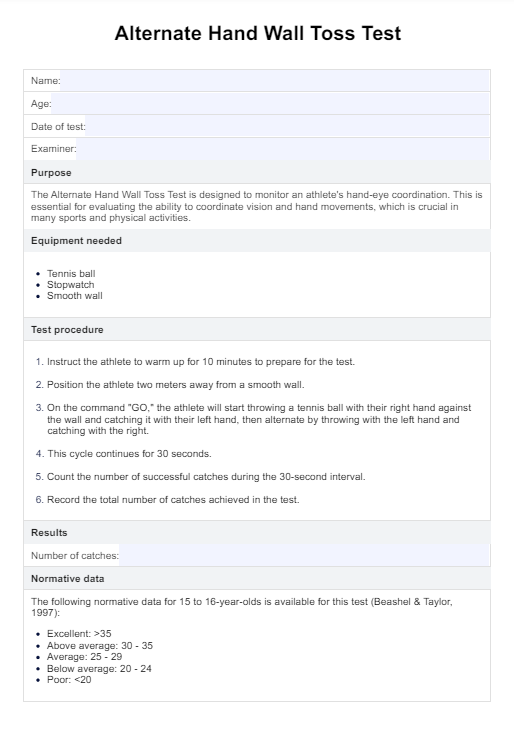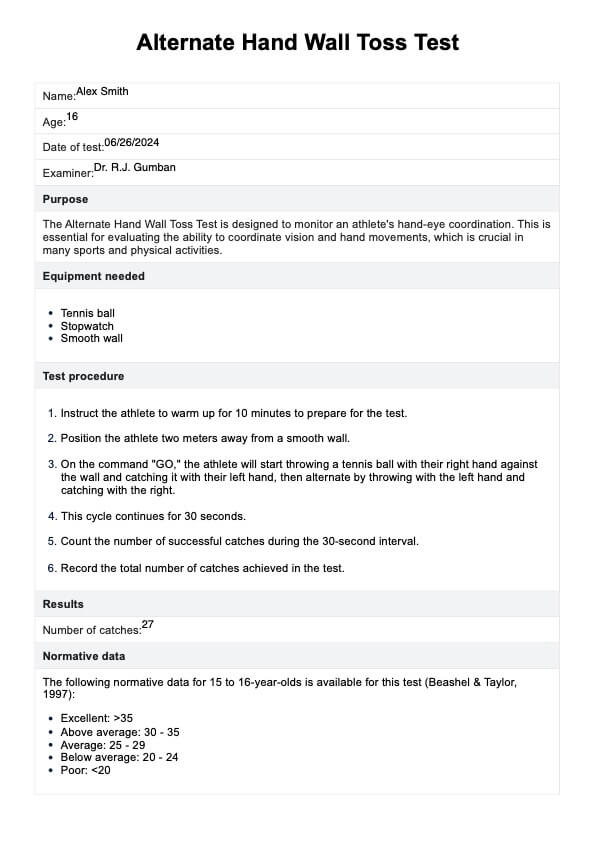Alternate Hand Wall Toss Test
Streamline hand-eye coordination assessments with our Alternate Hand Wall Toss Test template. Ensure accurate records and track athlete progress efficiently.


What is the Alternate Hand Wall Toss Test?
The Alternate Hand Wall Toss Test is designed to measure an athlete’s hand-eye coordination. The test's objective is to monitor the athlete's vision system to coordinate information received through the eyes to control hand-eye coordination in catching a ball. It involves the athlete standing far from a wall and alternately tossing and catching a tennis ball with both hands. This test benefits athletes who rely heavily on hand-eye coordination, such as baseball players, tennis players, and cricketers.
Alternate Hand Wall Toss Test Template
Alternate Hand Wall Toss Test Example
How to use our Alternate Hand Wall Toss Test template
The Alternate Hand Wall Toss Test template is designed to help healthcare professionals efficiently assess an athlete’s hand-eye coordination. To utilize the template effectively, follow these steps.
Step 1: Prepare the materials
Download a copy of our Alternate Hand Wall Toss Test template. Ensure you have all the necessary equipment ready: a tennis ball, a stopwatch, and a smooth and solid wall.
Step 2: Warm-up
Instruct the athlete to perform a 10-minute warm-up to ensure they are physically prepared for the test. This step helps prevent injuries and provides accurate results.
Step 3: Position the athlete
Have the athlete stand two meters away from the smooth wall. Explain the test procedure to the athlete to ensure they understand what is required, including throwing the ball against the wall with one hand, catching it with the opposite hand, and then throwing it back against the wall to catch it with the initial hand.
Step 4: Conduct the test
Upon the command "GO," ask the athlete to throw a tennis ball against the wall with their right hand and catch it with their left. Tell them to alternate by throwing with the left hand and catching with the right.
Step 5: Record results
Count the number of successful catches during the 30 seconds and record the result in the template. The document includes normative data for 15-16 years. However, this data should not be used for interpretation of test results as it only serves to compare the results with a specific population.
Scoring and results of the Alternate Hand Wall Toss Test
The Alternate Hand Wall Toss Test scoring is straightforward and relies on the number of successful catches an athlete makes within the 30-second testing period. Test reliability is crucial as it ensures the test consistently and stably measures the intended skill, influenced by factors such as the strictness of the test and the individual's motivation.
Normative data is used to compare an individual's performance to a population group. This data helps identify if the individual performs above or below average compared to others of similar age and gender.
However, it should be noted that the currently available normative data for the Alternate Hand Wall Toss Test only pertains to 15-16-year-olds (Beashel & Taylor, 1997) and should not be used for comparison for different populations.
Adaptations or variations of the Alternate Hand Wall Toss Test
The Alternate Hand Wall Toss Test can be adapted to suit different skill levels, environments, or specific training goals. These adaptations help maintain the test’s relevance and challenge for athletes of various abilities. Maintaining accurate and consistent results is crucial for future testing.
One common variation is adjusting the distance between the athlete and the wall. For beginners or younger athletes, reducing the distance to 1 meter can make the test more manageable. For advanced athletes, increasing the distance to 3 meters can add a higher level of difficulty.
Another adaptation involves altering the type of ball used. Instead of a tennis ball, healthcare professionals might use smaller or larger balls, or even balls with different weights, to tailor the challenge to the athlete’s specific needs.
Finally, the test can be modified to include variations in the throwing and catching technique. For example, using only one hand to throw and catch or alternating the throwing angle can introduce new challenges and help develop different aspects of hand-eye coordination. These adaptations ensure that the test remains engaging and beneficial for all athletes.
Benefits of using our template
Using the Alternate Hand Wall Toss Test template offers several advantages for healthcare professionals:
Streamlined assessments
Our template simplifies conducting the Alternate Hand Wall Toss Test, ensuring that assessments are performed consistently and efficiently. This allows healthcare professionals to focus more on analyzing results and less on administrative tasks.
Accurate record-keeping
The template ensures that all necessary patient information and test scores are accurately documented. This enhances the reliability of patient records and aids in tracking progress over time, leading to better-informed treatment decisions.
Easy comparisons
Our template provides a standardized format, making comparing results across different testing sessions easier. This helps identify trends and measure the effectiveness of interventions, thereby improving patient outcomes.
Reference
Beashel, P., & Taylor, J. (1997). Fitness for health and performance. In P. Beashel & J. Taylor (Eds.), The world of sport examined (p. 66). Thomas Nelson and Sons.
Commonly asked questions
The test measures an athlete’s hand-eye coordination by measuring the number of successful catches within 30 seconds. It also monitors the ability of the athlete's vision system to coordinate the information received through the eyes to control, guide, and direct the hands in activities such as catching a ball.
This test suits athletes of all levels who want to assess or improve their hand-eye coordination.
The test frequency can vary based on training goals but is typically performed periodically to monitor progress and the effectiveness of training programs.







































































































